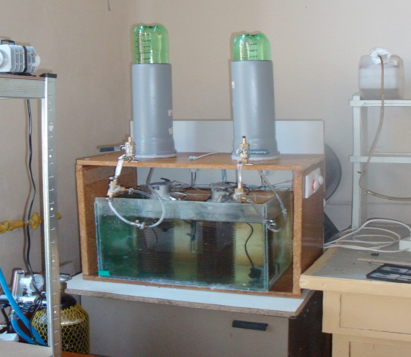Photobioelectrochemical conversion of wastes and raw material to produce electricity and energy carriers
Three ways of converting waste into energy or electricity are combined in this research. The first way concerns the energy conversion of wastewater organic compounds into hydrogen and electricity in biofuel cells. The second one is based on conversion of solar energy and organic compounds energy with using of inorganic photocathode in biofuel cell to produce hydrogen. The third way concerns the conversion of solar energy and inorganic waste gases on lipids of phototrophic microalgae. This combination of processes allows to convert different wastes into energy carriers and electricity.
The rational parameters of biotechnological process of hydrogen in bioelectrochemical system that allows to combine this process with wastewater treatment from nutrients (phosphorus and nitrogen) is proved. A technological scheme of malt plant wastewater treatment hydrogen production in bioelectrochemical systems was developed and its approbation was held on malt plant. The technology provides a gas mixture with 99 % of hydrogen with low energy costs and ensures the required quality of treated wastewater.
Methods of agricultural waste pre-treatment, depending on the composition of raw materials to produce hydrogen (chemical and biological), are proposed and technological conditions of processes are defined. With the purpose of hydrogen and electric current production technological scheme is proposed, in which such stages are consistently used: fermentation anaerobic degradation processes of solid wastes in the first reactor (pH 4-6), the use of soluble organic matter for hydrogen production in the second one (pH = 6-8) and electricity receiving in the refining of waste water in bioelectrochemical fuel cell. The terms of processes with maximum hydrogen yield are determined. The concentration of hydrogen in biogas is 50% while raw materials processing is 60%.
The possibility to produce hydrogen in microbial fuel cells with semiconductor photocathode was found. The value of the Coulomb efficiency was 3.12%, the rate of cathodic hydrogen recombination 1.19% hydrogen system performance 4.89%.
The possibility of microalgae Chlorella vulgaris cultivating usiing wastes of different origin is shown. The technological scheme of Chlorella vulgaris cultivating by simultaneous gas emissions and industrial wastes using to obtain biodiesel is developed. The process parameters are found. Maximum output of a lipid fraction (24%) occurs using of alternating light period from 4ҳ4 dark, temperature 30°C, pH 6.7, simultaneous supply of CO2 (gas emissions containing 6% of CO2, 0,5% of SO2, 1,5% NOx) and organic substance (sugars, urea, etc.). Influence of culture medium composition (concentrations of nitrogen, sulfur) on the growth of algae biomass and lipid fractions accumulation are studied.

| Attachment | Size |
|---|---|
| 387.19 KB |




